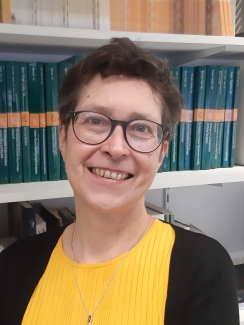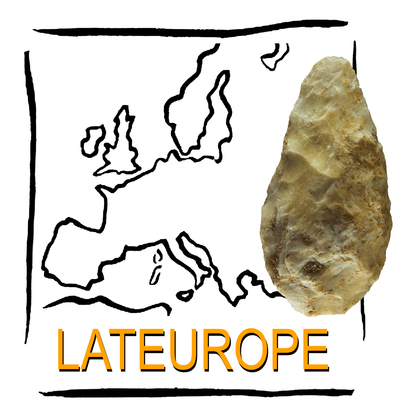
organizational unit
ROCEEH
Senckenberg Forschungsinstitut
Senckenberganlage 25
60325 Frankfurt am Main
Germany
Curriculum Vitae
Main research interests
- Human evolution and hominid ecology Paleoanthropology Mammal (Paleo)
- Biogeography Mammal paleobiology Island evolution
Academic background
since April 2008 scientific researcher for Paleobiology at Heidelberger Akademie der Wissenschaften at the Research Centre „The role of culture in early expansions of humans“ at the Senckenberg Research Institute, Frankfurt am Main.
2002-2008 scientific researcher in the Vertebrate Paleobiology Group at the Institute for Ecology, Evolution and Diversity, Department of Biosciences, Goethe University, Frankfurt am Main.
since 2002 teaching expertise in classes on Comparative Anatomy of Vertebrates, Vertebrate Paleobiology, Human Evolution, Mammalian (Paleo)Biogeography, Island Evolution at Goethe University, University of Tübingen, Institute Paléontologie Humain (Paris) and others.
2004-2007 coordinator of the research activities and scientific researcher in the HOPSea network (Human Origins Patrimony in South-East Asia) at the Frankfurt university in collaboration with the Institute Paléontologie Humain / Paris, Naturalis / Leiden, National Museum and University of the Philippines Diliman / Manila, and Institut Teknologi Bandung / Bandung.
2002-2007 scientific researcher for biology in the Junior Research Group „Demographic Trends, Needs and Supply Systems“ in the priority programme on Social Ecological Research in collaboration with the Institute for Social-ecological research, Frankfurt am Main.
2001 Scientific Coordinator of paleontological excavations at the Miocene Locality Eppelsheim on behalf of the Landessammlung für Naturkunde, Mainz.
2000 Dissertation in Biology (Dr. phil. nat.), University of Frankfurt. 1996-2000 Research assistant in the Department for Paleoanthropology, Senckenberg Research Institute, Frankfurt am Main.
1994 Diploma in Biology (Zoology, Anthropology/Human Genetics, Psychology), University of Frankfurt.
Selected publications and lectures
Reschke, J.O., Krüger, S., Hertler, C. (2024). ForeGatherer Model v2.0 (v1.0). Zenodo. DOI: 10.5281/zenodo.10853340.
Giemsch, L., Hertler, C. (2023): Makuyuni. In: Beyin, A., Wright D.K., Wilkins, J., Olszewski, D.I. (eds.): Handbook of Pleistocene Archaeology of Africa. Vol.2, pp. 11065-1116. Springer.
Kandel, A.W., Sommer, C., Kanaeva, Z., Bolus, M., Bruch, A.A., Groth, C., Haidle, M.N., Hertler, C., Heß,J., Malina, M., Märker, M., Hochschild, V., Conard, N.J., Schrenk, F., Mosbrugger, V. (2023): The ROCEEH Out of Africa Database (ROAD): An indispensable Research Tool for Quaternary Scientists. PLoS One 18(8): e0289513. DOI: 10.1371/journal.pone.0289513.
Kubat, J., Nava, A., Bondioli, L., Dean, M.C., Zanolli, C., Bourgon, N ., Bacon, A.-M., Demeter, F., Peripoli, B., Albert, R., Lüdecke, T., Hertler, C., Mahoney, P., Kullmer, O., Schrenk, F., Müller, W. (2023): Dietary strategies of Pleistocene Pongo sp. and Homo erectus on Java (Indonesia). Nature Ecology and Evolution. DOI: 10.1038/s41559-022-01947-0.
Reschke, J.-O., Hertler, C., Puspaningrum, M.R., Krüger, S. (2023): ForeGatherer Model v1.0 (v1.0). Zenodo. DOI: 10.5281/zenodo.7736326.
Rodríguez, J., Hölzchen, E., Caso, A.I., Berndt, J.O., Hertler, C., Timm, I.J., Mateos, A. (2023): Computer simulation of scavenging by hominins and giant hyenas in the late Early Pleistocene. Nature Scientific Reports 13. 14283. DOI: 10.1038/s41598-023-39776-1.
Hertler, C., Reschke, J.-O., Hölzchen, E., Anwar, I.P., Puspaningrum, M.R-. Büscher, N., Ngetich, E.K. (2022): SEAcross ABM V1.0 (1.0). Zenodo. DOI: 10.5281/zenodo.6833780.
Hertler, C. and the ROCEEH Team (2022): The Map Module for the ROAD database. In: Kandel, A.W., Haidle, M.N., Sommer, C. (eds): Human Origins - Digital Future: An International Conference about the Future of Archaeological and Palaeoanthropological Databases. Propylaeum, Heidelberg, pp.43-44.
Hölzchen, E, Hertler, C., Wilmes, C., Anwar, I.P., Mateos, A., Rodríguez, J., Berndt, J.O. & Timm, I.J. (2022): Estimating crossing success of human agents across sea straits out of Africa in the Late Pleistocene. Palaeogeography, Palaeoclimatology, Palaeoecology 590, 110845. DOI: 10.1016/j.palaeo.2022.110845.
Bolus, M., Bruch, A., Haidle, M., Hertler, C., Heß, J., Kanaeva, Z., Kandel, A., Malina, M. & Sommer, C. (2021): Durch die Menschheitsgeschichte mit dem neuen ROAD Summary Data Sheet. Archäologische Informationen 43, 413.
Bolus, M., Bruch, A., Haidle, M., Hertler, C., Heß, J., Kanaeva, Z., Kandel, A., Malina, M. & Sommer, C. (2021): Explore the history of humanity with the new ROAD Summary Data Sheet. Archäologische Informationen 43, 413-414.
Hölzchen, E., Hertler, C., Mateos, A., Rodriguez, J., Berndt, J.O. & Timm, I.J. (2021): Discovering the opposite shore: How did hominins cross sea straits?. PLoS One 16(6), e0252885. DOI: 10.1371/journal.pone.0252885.
Bolus, M., Bruch, A., Haidle, M.H., Hertler, C., Heß, J., Kanaeva, Z., Kandel, A.W., Malina, M. & Sommer, C. (2020): Explore the history of humanity with the new ROAD Summary Data Sheet. MGfU 29, 145-147. DOI: 10.51315/mgfu.2020.29008.
Haidle, M. N., Bolus, M., Bruch, A. A., Hertler, C., Hochschild, V., Kanaeva, Z., Sommer, C. & Kandel, A. W. (2020): Human Origins—Digital Future, an international conference about the future of archeological and paleoanthropological databases. Evolutionary Anthropology. DOI: 10.1002/evan.21870
Wirkner, M. & Hertler, C. (2019): Feeding ecology of Late Pleistocene Muntiacus muntjak in the Padang Highlands (Sumatra). Comptes rendus Palevol 18 (5) 541-554. Elsevier Masson SAS. DOI: 10.1016/j.crpv.2019.03.004
Giemsch, L., Hertler, C., Märker, M., Quénéhervé, G., Saanane, C. & Schrenk, F. (2018): Acheulean Sites at Makuyuni (Lake Manyara, Tanzania): Results of Archaeological Fieldwork and Classification of the Lithic Assemblages. African Archaeological Review, DOI: 10.1007/s10437-018-9284-4.
Bachofer, F., Quénéhervé, G., Hertler, C., Giemsch, L., Hochschild, V. & Maerker, M. (2018): Paleoenvironmental Research in the Semiarid Lake Manyara Area, Northern Tanzania: A Synopsis. In: C. Siart, M. Forbriger, O. Bubenzer (eds.), Digital Geoarchaeology. New Techniques for Interdisciplinary Human-Environmental Research. Cham: Springer, 123-138.
Volmer, R., Hölzchen, E., Wurster, A., Ferreras, M. R. & Hertler, C. (2017): Did Leopards (Panthera pardus) become extinct because of competition for prey? Modelling interspecific competition within the Late Pleistocene carnivore guild of the Padang Highlands, Sumatra. Palaeogeography, Palaeoclimatology, Palaeoecology 487, 175-186. DOI 10.1016/j.palaeo.2017.08.032.
Rodríguez, J., Mateos, A., Hertler, C. & Palombo, M.R. (2016) (volume eds): The power of models: Mathematical approaches to the study of human-fauna interactions in the Pleistocene. Quaternary International. 413, 2-6. DOI: 10.1016/j.quaint.2016.09.005.
Rodríguez, J., Mateos, A., Hertler, C. & Palombo, M.R. (2016): Modelling human presence and environmental dynamics during the Mid-Pleistocene Revolution: New approaches and tools. Quaternary International 393, 19-23. DOI: 10.1016/j.quaint.2015.06.003.
Volmer, R. & Hertler, C. (2016): The effect of competition on shared food resources in carnivore guilds. Quaternary International 413,32-43. DOI: 10.1016/j.quaint.2015.11.054.
Timm, I.J., Lorig, F., Hölzchen, E. & Hertler, C. (2016): Multi-Scale Agent-Based Simulation of Long-Term Dispersal Processes: Challenges in Modeling Hominin Biogeography and Expansion. In: Barceló, J.A., Del Castillo, F. (eds.) Simulating Prehistoric and Ancient Worlds. Springer, Cham, 141-159.
Hölzchen, E., Hertler, C., Timm, I. & Lorig, F. (2016): Evaluation of Out of Africa hypotheses by means of agent-based modelling. Quaternary International413, Part B, 78-90. DOI: 10.1016/j.quaint.2015.11.022.
Volmer, R., Hertler, C. & van der Geer, A. (2016): Niche overlap and competition potential among tigers (Panthera tigris), sabertothed cats (Homotherium ultimum, Hemimachairodus zwierzyckii) and Merriam's Dog (Megacyon merriami) in the Pleistocene of Java. Palaeogeography, Palaeoclimatology, Palaeoecology 441, 901-911. DOI: 10.11016/j.palaeo2015.10039.
Rodríguez, J., Mateos, A., Hertler, C. & Palombo, M.-R. (2016): Modelling human presence and environmental dynamics during the Mid-Pleistocene Revolution: new approaches and tools. Quaternary International 393, 19-23. DOI: 10.1016/j.quaint.2015.06.003.
Steigerwald, S., Haidle, M.N., Bruch, A.A. & Hertler, C. (2015): Conference report: Expansions 2015, Frankfurt am Main, Germany, 13-17 July 2015. Mitteilungen der Gesellschaft für Urgeschichte 24, 175-178.
Kandel, A.W., Bolus, M., Bretzke, K., Bruch, A.A., Haidle, M.N., Hertler, C. & Märker, M. (2015): Increasing Behavioral Flexibility? An Integrative Macro-Scale Approach to Understanding the Middle Stone Age of Southern Africa. Journal of Archaeological Method and Theory, 23(2), 623-668. DOI: 10.1007/s10816-015-9254-y.
Hertler, C., Bruch, A.A. & Märker, M. (2014): Ecospace — der ökologische Raum von Hominiden. Senckenberg - natur forschung museum 144 (7/8), 262-265.
Schrenk, F. & Hertler, C. (2014): Ursprung und Ausbreitung früher Menschen. In: Trümpler, C., Ich sehe wunderbare Dinge 100 Jahre Sammlungen der Goethe-Universität, 286-287.
Hertler, C., Bruch, A.A. & Märker, M. (2013): The earliest stages of hominin dispersal in Africa and Eurasia. In: Bellwood, P. (Ed.): Encyclopedia of Global Human Migration. Vol. 1. Wiley Blackwell, pp. 1-9.
Hertler, C. & Palombo, M.-R. (2012): Linked Effects of Climate Change, Orbital Forcing, Tectoonics and biotic interaction: A research agenda for studying faunal evolution and hominin dispersal patterns. Quaternary International 279-280, 196.
Bolus, M. & Hertler, C. (2012): Jenseits von Afrika. Archäologie in Deutschland 4/2012, 22-23.
Kandel, A.W. & Hertler, C. (2012): Homo sapiens … „wo noch nie zuvor ein Mensch gewesen ist“. Archäologie in Deutschland 4/2012, 28-29.
Märker, M. & Hertler, C. (2011): Arachaeological site prediction and landscape reconstruction in the Lake Manyara area, Northern Tanzania. Proceedings on Computer Applications and Quantitative Modelling in Archaeology 2011.
Paudayal, K.N., Panthee, S. & Hertler, C. (2011): A bovid specimen from Late Pleistocene deposits in the Kathmandu Basin, Nepal. Journal of Stratigraphic Association of Nepal 7, 9-14.
Haidle, M.N., Bolus, M., Bruch, A.A., Hertler, C., Kandel, A.W., Märker, M., Conard, N.J., Hochschild, V., Schrenk, F. & Mosbrugger, V. (2010): The role of culture in early expansions of humans – A new research center. Quaternary International 223-224,429-430.
Gutmann, M., Hertler, C. & Schrenk, F. (2010): Der Mensch als Gegenstand der Paläoanthropologie und das Problem der Szenarien. In: Gerhardt, V. & Nida-Rümelin, J. (eds) Evolution in Natur und Kultur. de Gruyter, Berlin, pp. 135-162.
Märker, M., Bachofer, F., Quénéhervé, G., Hertler, C., Sanaane, C., Giemsch, L. & Thiemeyer, H. (2010): Modelling the spatial distribution of Paleontological sites in the Makuyuni region, Tanzania. In: Melero, F.J., Cano, P., Revelles, J. (eds.) Fusion of Cultures. Abstracts of the XXXVIII Conference on Computer Applications and Quantitative Methods in Archaeology, 147-150.
Kaiser, T., Seiffert, C., Hertler, C., Fiedler, L., Schwartz, H.L., Frost, S.R., Giemsch, L., Bernor, R.L., Wolf, D., Semprebon, G., Nelson, S.V., Schrenk, F., Harvati, K., Bromage, T.G. & Saanane, C. (2010): Makuyuni, a new Lower Palaeolithic Hominid Site in Tanzania. Mitteilungen des Hamburgischen Zoologischen Museum und Institut 106, 69-110.
Mishra, S., Gaillard, C., Hertler, C., Moigne, A.-M. & Simanjuntak, T. (2010): India and Java: Contrasting records, intimate connections. Quaternary International 223-224, 265-270.
Hertler, C. (2009): Wandlungen in den Beziehungen zwischen Menschen und ihrer Umwelt. In: D. Bandini, U. Kronauer (eds.) Früchte vom Baum des Wissens. 100 Jahre Heidelberger Akademie der Wissenschaften. Eine Festschrift der wissenschaftlichen Mitarbeiter. Universitätsverlag Winter, Heidelberg, 43-47.
Hertler, C. (2008): Modeling food supply and demongraphy in prehistoric human populations. In: Hummel, D. (ed.): Population Dynamics and Supply Systems, campus, Frankfurt/Main, 73-98.
Hertler, C. & Volmer, R. (2008): Assessing prey competition in fossil carnivore communities - a scenario for prey competition and its evolutionary consequences for tigers in Pleistocene Java. Palaeogeography, Palaeoclimatology, Palaeoecology 257 (1–2), 67–80.
Hertler, C., de Vos, J. & Bautista, A. (2008): Dwarfing and gigantism. In: Sémah, A.M., Setiagama, K., Sémah, F., Détroit, F., Grimaud-Hervé, D., Hertler, C. (eds.) First Islanders – Human Origines Patrimony in Southeast Asia. Exhibition Catalogue, 76-80.
Hertler, C. (2008): Jenseits von Afrika – Expansionen früher Menschen. In: Müller, H.A. (ed.) Evolution: Woher und Wohin? Vandenhoek und Ruprecht, Stuttgart, 110-119.
Research Projects
LATEUROPE - Why late earliest occupation of Western Europe?

Modeling Team in the research project funded by the European Research Council
Contact: lateurope.cnrs.fr
Project participants:
Marie-Hélène Moncel, Paris, France (project leader)
Carolina Cucart-Mora, Paris, France (coordinator of the modeling team)
Harry Hall, Liverpool, UK
Kamilla Lomborg, Toulouse, France
Jan-Olaf Reschke, Frankfurt/Main, Germany
Christine Hertler, Frankfurt/Main, Germany
Matt Grove, Liverpool, UK
Mehdi Saqalli, Toulouse, France

